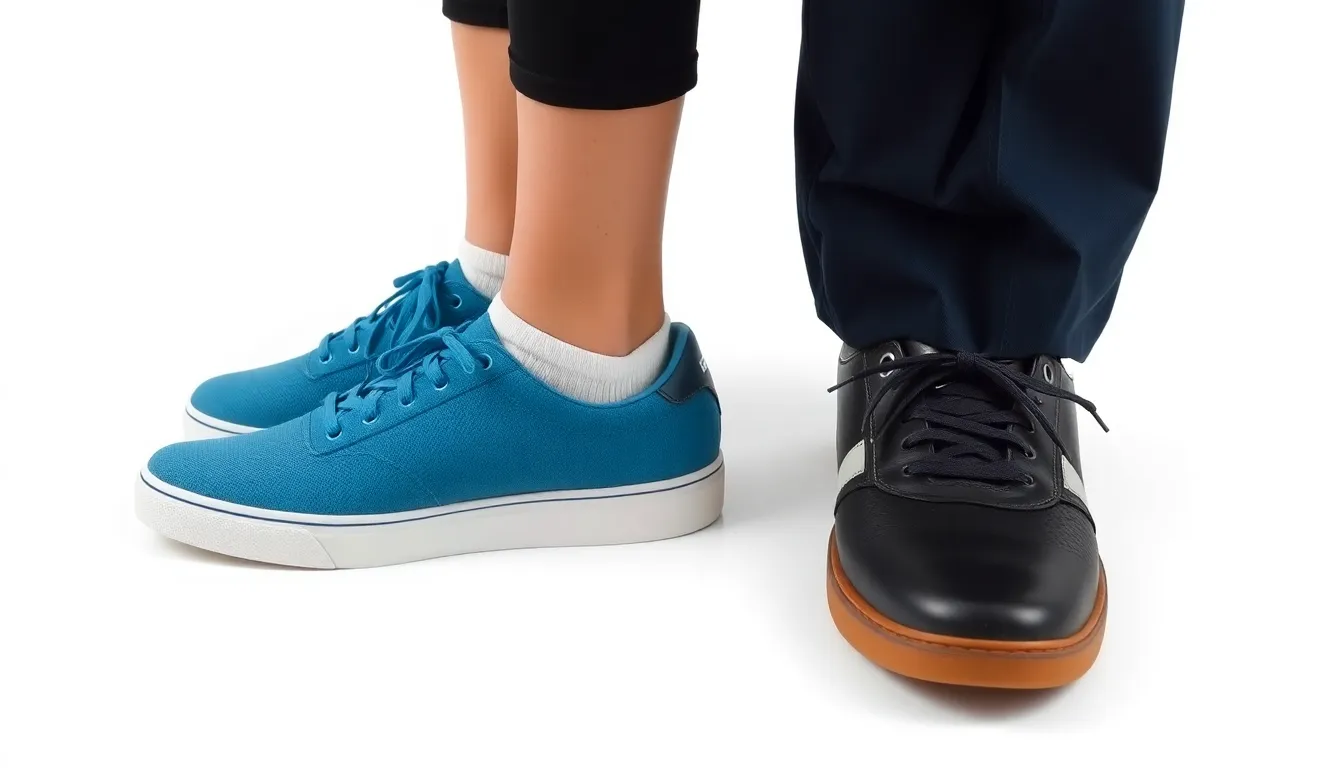When it comes to shoe sizes, navigating the differences between women’s and men’s sizing can be tricky. Many people find themselves confused when trying to convert a size 11 in women’s shoes to its equivalent in men’s. Understanding these conversions is essential for making informed purchases, especially in today’s diverse fashion landscape where styles often blur gender lines.
This article breaks down the conversion process, providing clarity on how women’s size 11 translates to men’s sizing. With this knowledge, shoppers can confidently explore their options and find the perfect fit, whether they’re shopping for athletic shoes, casual sneakers, or stylish boots. Let’s dive into the details and simplify the sizing game.
Table of Contents
ToggleUnderstanding Shoe Size Conversions
Women’s and men’s shoe sizes differ significantly, and understanding these differences is crucial for accurate conversions. A direct translation between sizes often does not exist, leading to confusion when selecting footwear.
The Differences Between Women’s and Men’s Sizes
Shoe size systems vary primarily due to design and fit. Women’s shoes typically cater to narrower feet, featuring different arch heights. For instance, a men’s size 11 generally equals a women’s size 12.5. This discrepancy arises from the way both categories are sized. Men’s shoes are often labeled in whole sizes, while women’s shoes include half sizes, further complicating the conversion.
How to Measure Your Feet Accurately
Accurate foot measurements simplify the conversion process. To measure feet, follow these steps:
- Stand on a piece of paper – Ensure weight is evenly distributed.
- Trace the outline of the foot – Use a pencil to mark the longest toe and the back of the heel.
- Measure the length – Use a ruler to determine the distance from the back of the heel to the longest toe in inches or centimeters.
- Measure the width – Find the widest part of the foot and note the measurement.
Measuring both feet is essential, as one foot may be larger than the other. Use the larger measurement when converting sizes. Understanding accurate foot dimensions aids in finding the appropriate shoe size across different brands and styles.
Overview of 11 in Women’s to Men’s Sizes

Understanding the conversion from women’s size 11 to men’s sizes enhances shopping efficiency. Clarifying this process ensures consumers find the right fit in diverse footwear.
What Does 11 in Women’s Convert to in Men’s?
A women’s size 11 typically converts to a men’s size 9.5. This conversion accounts for the general 1.5 size difference commonly observed between genders. For accurate fitting, it’s essential to confirm individual brand charts, as some brands may vary slightly.
Factors That Influence Size Conversion
Several factors influence size conversion in footwear, including:
- Design Differences: Women’s shoes often feature a narrower fit and higher arches, requiring adjustments in sizing.
- Brand Variability: Each footwear brand may implement unique sizing charts, impacting overall size translation.
- Foot Shape Variations: Each person’s foot shape, width, and volume can affect sizing, causing discrepancies even within the same shoe size.
- Style Considerations: Athletic shoes, casual sneakers, and boots can fit differently based on style expectations and intended use, affecting the perceived size.
These factors contribute to the complexity of finding the correct shoe size and highlight the importance of measuring and checking specific brand guidelines.
Popular Brands and Their Size Charts
Understanding brand-specific size charts enhances the conversion process from women’s to men’s sizes. Each brand may have unique sizing guidelines that can affect fit.
Brand-Specific Guidelines for Shoe Conversions
- Nike
Nike typically follows the general conversion of women’s size 11 to men’s size 9.5. However, styles may vary, so it’s advisable to refer to Nike’s specific size chart for each model.
- Adidas
Adidas generally adheres to the 1.5 size difference. A women’s size 11 usually translates to men’s size 9.5, but confirm with the Adidas size guide due to slight variations in design.
- New Balance
New Balance offers an extensive size range. Women’s size 11 converts to men’s size 9.5, but some models may differ. Check the size chart for any model-specific adjustments.
- Puma
Puma maintains a straightforward conversion system where women’s size 11 equals men’s size 9.5. Still, it’s crucial to verify each style’s size chart as dimensions may differ.
- Reebok
Reebok typically follows the standard conversion, with women’s size 11 translating to men’s size 9.5. Individual shoe styles may fit differently, so review Reebok’s sizing information.
Notable Exceptions to the Standard Size Conversion
Certain brands show deviations from the typical 1.5 size difference.
- Dr. Martens
Dr. Martens shoes often fit larger. A women’s size 11 might convert to a men’s size 10 or even 10.5. It’s important to try them on or consult the brand’s specific guidance on fit.
- Vans
Vans provides less consistent sizing. A women’s size 11 could represent a men’s size 9.5 or even 10, depending on the style. Referencing the specific size chart is essential for the best fit.
- Converse
Converse typically employs unisex sizing, complicating conversions. A women’s size 11 corresponds to a men’s size 9.5, but styles can fit differently. Review the sizing guide for individual models.
By referring to these brand-specific guidelines and noting exceptions during the conversion process, shoppers can make more informed decisions on fit and comfort.
Tips for Choosing the Right Size
Choosing the right shoe size enhances comfort and functionality. Following specific guidelines can streamline the selection process and ensure a better fit.
Trying on Shoes: The Best Practices
- Measure Feet: Always measure both feet, as one may be larger. Use a measuring tape or ruler for length and width.
- Try Different Times: Feet swell during the day. Trying shoes in the afternoon or evening yields a more accurate fit.
- Wear Appropriate Socks: Use the type of socks usually worn with the shoes. This affects sizing and overall comfort.
- Walk Around: Take a few steps in the shoes. Ensure there’s enough space at the toe and that the heel fits snugly.
- Check for Pressure Points: Identify any discomfort while walking or standing. If the shoes pinch or cause friction, they likely don’t fit correctly.
The Importance of Fit and Comfort
- Support: Properly fitting shoes provide arch support and stability, reducing the risk of injury.
- Foot Shape: Every foot is unique. Consider width and arch height when selecting shoes to ensure comfort throughout the day.
- Style Versus Fit: Prioritize fit over style. A well-fitting shoe enhances performance and prevents foot ailments.
- Brand Differences: Recognize that sizes may vary by brand. Refer to specific brand size charts for accurate measurements.
- Insoles and Adjustments: Custom insoles can improve fit for particular foot shapes. They can also provide additional cushion and support.
Understanding the conversion from women’s size 11 to men’s size 9.5 is essential for anyone navigating the world of footwear. With significant differences in design and fit between genders it’s crucial for shoppers to consult brand-specific size charts. This ensures a proper fit that prioritizes comfort and functionality.
Taking the time to measure feet accurately and consider individual brand guidelines can make all the difference. By focusing on fit over style and being aware of the unique characteristics of each brand, shoppers can confidently choose shoes that provide both support and style. Ultimately, a well-fitting shoe enhances overall comfort and reduces the risk of foot-related issues.






